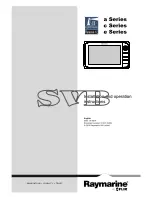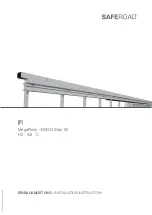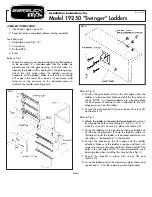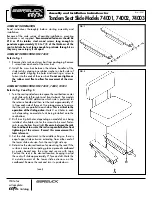
1949310
V1.1
21 March 2019
Installation:
This LFLLED Surface Mount Non-maintained Emergency can be installed on PLASTER or solid block
walls.
1. Take off the front external cover by inserting a flat blade screw driver into the slots along the
bottom edge of the fitting.
2. Mark the mounting hole positions on the wall and drill fixing holes.
3. Using the appropriate fixing hardware for the wall surface to then fix the LFLLED to the wall
4. Terminate the 240V, 50Hz supply to the terminals marked A, N & E. The cable entry can be
through the back of the unit or from the side as shown in the image below. Install the internal
cover plate over the top of the terminal block.
5. Re-install the External Front Cover by pushing it back into place until it clicks in top and bottom.
6. Adjust the LED heads into position. Two screws are provided for each head to move them into
position. The front screw adjusts the L/R position (roll) and the side screw adjusts the U/D (tilt)
position. There is a standard positioning marker on the body representing a 30° roll out and
30° tilt down – this is the position that provides the maximum square area coverage when wall
mounted at 3m.
7. This luminaire contains non-user replaceable light source and battery.
8. If the CTP capabilities are activated, please affix the CTP Status Label to a visible surface.
Networking:
When installing the product on a monitored network, (ZONEWORKS, DATA, DALI) simply insert the
relevant Smart Node PCA.
Images and Dimensions:
Testing Procedure:
When the unit is connected to the un-switched active, it must be allowed to charge the battery for at
least 24 hours. The emergency lamp only illuminates during a power fail. Conduct the following tests:
•
The emergency lamp must illuminate for at least 180 min after disconnection from the mains. If the
unit fails to illuminate for the requisite time, remedial action must be taken to repair the situation
and once completed, the unit must pass a subsequent test.
•
Press and hold Test Button or switch Off Mains Supply, check that the emergency lamp is On.
•
Release the Test Button or Switch On Mains Supply, check that the emergency lamp is Off (Non-
maintained operation).
Below are a list of common problems and their possible causes:
Fault: The Green LED indicator is not illuminated.
Check: A.C. is connected and is turned on.
Battery is connected.
Test Switch for damage.
Fault: Lamp does not illuminate in emergency mode.
Check: A.C. is connected.
Lamp is correctly inserted.
Battery is connected
Fault: Lamp illuminates in emergency mode, but only stays on for a short period.
Check: Battery has been allowed to charge for at least 24 hours.
Battery for damage.
Caution:
On many building sites, power circuits may be cut off in an uncontrolled and repetitive basis during
construction. As a result, any Supalite units, on these circuits, will have their batteries discharged or
“cycled”. The Li-ion battery in the Supalite has been selected to give excellent long life performance in a
controlled IEC 60598-2-22 testing environment. Excessive battery cycling will reduce through-life
performance and may lead to premature battery failure. Battery warranty claims as a result of such
abuse, are specifically EXCLUDED from Clevertronics warranty terms.
Warranty:
For Product Warranty information and Terms and Conditions of Sales please refer to our website
https://clevertronics.com.au/warranty-statement/




















